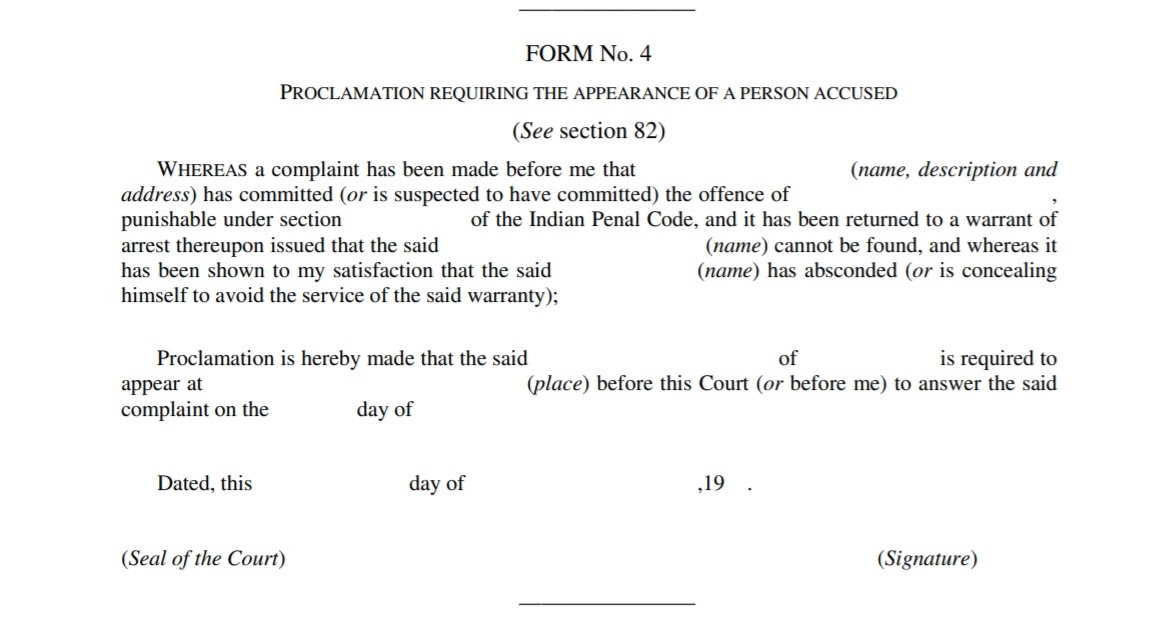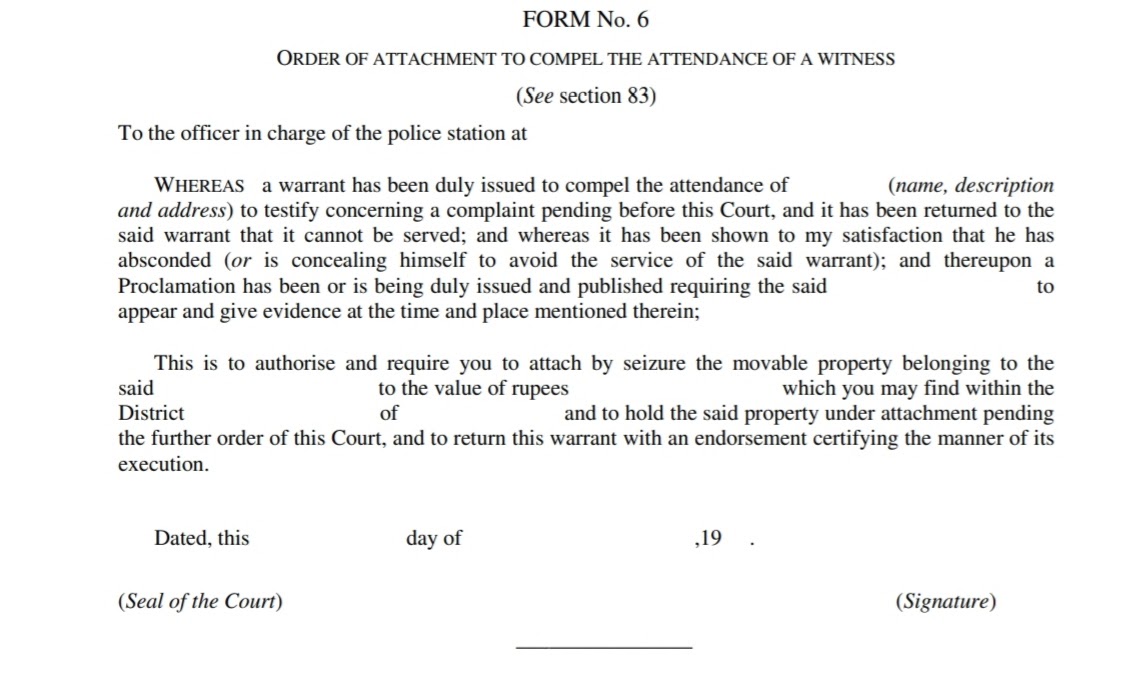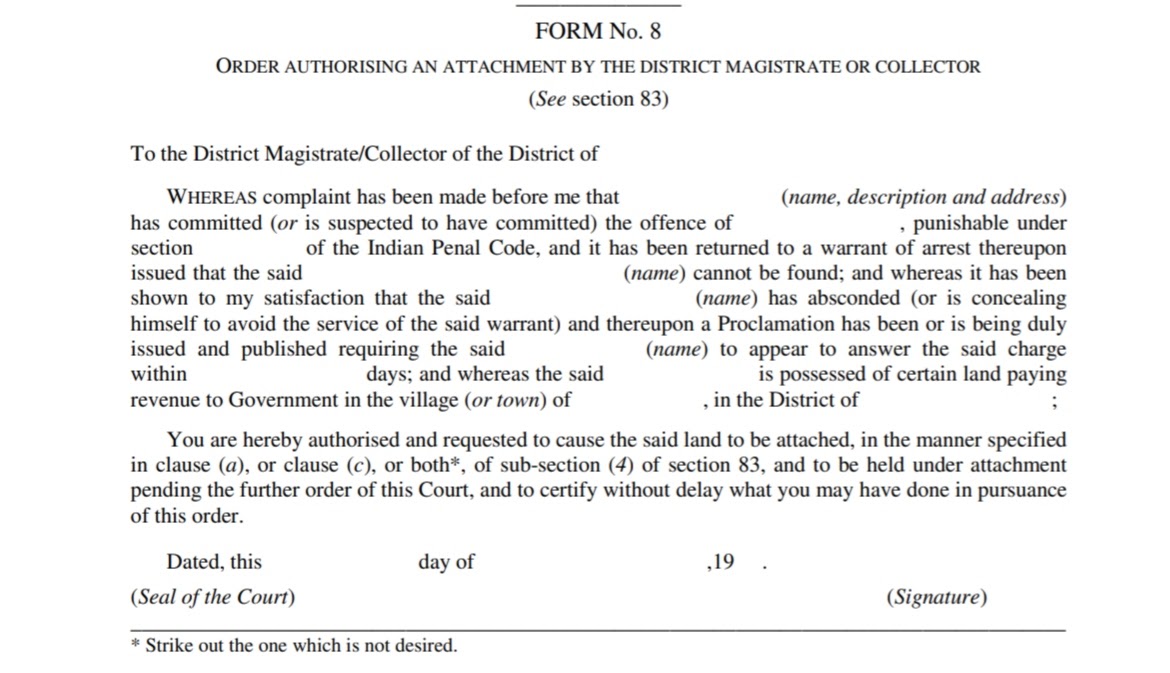This article is written by Vandana Shrivastava, a student of B.A.L.L.B.(Hons.) at the Institute of Law, Nirma University, Ahmedabad. It illustrates the process governing the issuance of proclamation and conditions when the property of the proclaimed offender is attached.
Table of Contents
Introduction
A majority of the criminals elope after the commission of a crime, to escape from the law. Had it been the solution to save oneself from being punished for a crime or a wrong, commission of crimes would have ended up becoming very common. However, there are several occasions when criminals and defaulters surrender themselves before the Police or the Court. It is often because they realise their mistake and other times, it is because the Court procures something that is most valuable to them- ‘their property’.
The Code of Criminal Procedure (CrPC) is a procedural law. It elucidates the manner in which trials shall be conducted. The property is attached to attract the physical presence of an accused when they do not present themselves after the issuance of notices and warrants. But there are several underlying factors like time, reasons behind the absence of the person, nature of property attached, interested parties to a property and so on. This article is an illustration of the provisions governing proclamation and attachment of property under CrPC.
Proclamation
In a legal sense, the term ‘proclamation’ refers to an official announcement. Here, it is one of the ways of compelling a person to present himself before the Court of law.
Background
Section 204(1) of The Code of Criminal Procedure, 1973 (CrPC) states that when the Magistrate who is empowered to take cognizance is satisfied that the case is a:
- Summons case, then he shall issue a summons for the attendance of the person accused.
- Warrant case, then he may issue a warrant or a summons to present the accused before the Court at a certain time.
Section 204(5) states that nothing in this section shall affect the provisions of Section 87 of the Code. The said Section states that the Court that is empowered to issue a summons for a person’s appearance may issue an arrest warrant against the said person by penning down the reason behind the same, if:
- The Court has a reason to believe that the person has absconded or would not abide by the summons before or after the issuance of summons, but before the date when the concerned person was required to present himself before the Court; or
- The person fails to present himself before the Court and the summons has been served duly on time and no reasonable excuse behind such failure has been given to the Court.
Conditions to make a Proclamation
Section 82 of the CrPC has laid down the conditions when a person could be proclaimed as an absconding offender. In situations when a Court has issued a warrant against a person and the Court has a reason to believe that such person has either eloped or is concealing himself so as to ditch the Court, the Court may issue an order of proclamation against such person, ordering them to appear before the Court on a certain date, at a certain time.
The specimen of proclamation requiring the appearance of the accused person is provided under Form Number 4 of the Second Schedule of CrPC. The form is attached as under:
The Court can issue an order of proclamation, both before and after procuring evidence against the person who is absconding. It should be noted that the person to whom the proclamation is addressed shall be given a period of a minimum of 30 days to present themself before the Court.
Under Section 82(4) IPC, when a person accused of commission of the offences punishable under the below-stated Sections of the Indian Penal Code of 1860 (IPC) fails to appear before the Court as required under the proclamation, the Court may, if it deems fit, declare such person as a ‘proclaimed offender’ and make an announcement to that effect. The offences are:
- Section 302– Offense of murder.
- Section 304– Offense of culpable homicide not amounting to murder.
- Section 364– Offense of kidnapping or abducting to commit murder.
- Section 367– Offense of kidnapping or abducting in order to subject a person to grievous hurt, slavery, etc.
- Section 382– Offense of theft and preparation made for causing death, hurt or restraint in order to the committing of the theft.
- Section 392– Offense of robbery.
- Section 393– Offense of attempt to commit robbery.
- Section 394– Offense of Voluntarily causing hurt in committing robbery.
- Section 395– Offense of dacoity.
- Section 396– Offense of dacoity with murder.
- Section 397– Offense of robbery, or dacoity, with an attempt to cause death or grievous hurt.
- Section 398– Offense of attempt to commit robbery or dacoity when armed with a deadly weapon.
- Section 399– Offense of making preparation to commit dacoity.
- Section 400– Offense of belonging to the gang of dacoits.
- Section 402– Offense of assembling for the commission of dacoity.
- Section 436– Offense of mischief by fire or explosive substance with intent to destroy a house, etc.
- Section 449– Offense of house-trespass in order to commit an offence punishable with death.
- Section 459– Offense of grievous hurt caused whilst committing lurking house-trespass or house-breaking.
If the person fails to present himself/herself before the Court after the period which was granted to them, then the Court may declare them as a proclaimed offender.
The manner in which Proclamation shall be made
Sub-section 2 of Section 82 of the CrPC specifies the manners in which a proclamation can be made. They are as follows:
- The proclamation shall be read out publicly in a noticeable area that falls under the vicinity of the residential address of the person or it shall be attested to some part of the person’s house or on a nearby building. Either of those should be attested to someplace which is observable; or
- It shall be attached to a noticeable place in the Court.
- If the Court deems fit, it might give orders for publishing the proclamation on the newspaper which is circulated in the vicinity of the person’s residence.
Punishment for non-appearance after the issue of Proclamation u/s 82 of the CrPC
The Criminal Law (Amendment) Act of 2005 inserted Section 174-A in the IPC. It states that when a person fails to abide by the terms of the proclamation u/s 82(1) of the CrPC, he/she shall be punished with imprisonment for a period of maximum three years.
In case of non-abidance to the proclamation issued under offences laid down u/s 82(4) of the CrPC and the person has been announced as a proclaimed offender, the punishment shall be imprisonment for a term that may extend to seven years and a fine could also be imposed on same.
Attachment of property
The Court that issues the proclamation might attach any movable or immovable property of such person under Section 83 of the CrPC when it has a reason to believe (by an affidavit or other evidence) that the person is making an attempt to:
- dispose of the immovable property; or
- is going to transfer the immovable property either entirely or partially, to an area outside the local jurisdiction of the concerned Court.
The Court’s order to attach the property would be authorized within the local jurisdiction. If the attached property is located in another area, then it would be authorized after being endorsed by the District Magistrate of the concerned area. The order of attachment under Form no. 7 of the Second Schedule of CrPC to compel the appearance of an accused person is as under:
The order of attachment under Form no. 6 of the Second Schedule of CrPC to compel the attendance of a witness is as under:
Movable Property
On some occasions, the property to be attached might be a debt or a movable property. Section 83(3) has laid down the manner in which such properties could be attached:
- By seizing such property; or
- By appointing a receiver;
- By issuing an order which will obstruct such property from being delivered to the proclaimed offender or someone who might receive it on his behalf; or
- In any way that the Court deems fit.
Immovable Property
If the property which has to be attached is immovable, it will be attached in the following manner:
- The attachment will be made via Collector of the district where the property is situated when the matter concerns land paying revenue to the State government.
In other cases, the property will be attached:
- By taking possession of the property or by appointing a receiver; or
- By issuing an order restricting the payment of rent to the person absconding or to anyone on his behalf; or
- In any way, the Court deems fit.
Perishable Property
If the property to be attached is or is inclusive of livestock or perishable goods, then the Court may grant an order directing the immediate sale of the property. Livestock implies farm animals which are valued as assets. The proceeds earned from such sale would be put to use in the way directed by the Court.
Receiver
Section 83(6) of the Code states that the powers, duties and liabilities of the receiver shall remain the same as specified under the Code of Civil Procedure, 1908 (CPC).
The receiver is defined under Order 40 of Code of Civil Procedure, 1908 (CPC) as an independent and impartial person, appointed by the Court to administer or manage a property that is involved in a dispute. The said person does not represent any of the parties in a case. He is the officer of the Court who works in the common interest of the parties. For instance, he shall manage a disputed property until the case is not settled. Sections 83(3)(b) and 84(4)(b) of the Code provide for the appointment of a receiver for the purpose of attaching a property. The plaintiff or the defendant could request the appointment of the receiver. The appointment of a receiver, however, is a discretionary power of the Court.
Appointment of Receiver
Rule 1(1) of Order XL is concerned with the appointment of a receiver. When the Court finds it just and convenient, it may order:
- The appointment of a receiver of any property, either before or after decree;
- The removal of property from the possession of any person and commit the possession, custody or management of the same property to the receiver.
Powers of Receiver
Rule 1(1)(d) empowers the receiver to bring and defend suits. The receiver is empowered with the realization, management, protection, preservation, and improvement of the property. He can collect rent and profits generated from the property, apply and dispose of them, and execute the documents like the owner himself does, so far as the Court deems fit.
Duties of Receiver
The duties of a receiver are laid down under Rule 3 of Order XL. It states that every receiver is required to:
- Furnish something the Court deems fit as security to account for the proceeds or benefits that he shall receive out of the property;
- Submit his accounts whenever the Court directs, in the same manner as directed by the Court;
- Make a payment of the outstanding amount as directed by the Court; and
- Be held responsible for any loss incurred to the property by the wilful default or gross negligence on the part of the receiver.
Liabilities of Receiver
The liabilities of the receiver are enumerated under Rule 4 of Order XL. The liability/liabilities or the receiver shall arise on:
- Failure to submit the accounts as and when directed by the Court;
- Failure to pay the outstanding amount as directed by the Court; or
- Incurring a loss to the property due to his wilful default or gross negligence. In the event of such occurrence, the Court may direct to attach the receiver’s property and may sell the same to reimburse for the amount due or loss incurred due to the conduct of the receiver. If any amount is left after the sale of the receiver’s property and after clearing out the overdue amount or loss, the amount left after meeting all aforementioned requisites shall be returned to the receiver.
Form Number 8 of the Second Schedule is the specimen for the order to authorise an attachment by the District Magistrate or Collector u/s 83 of the CrPC.
Claims and Objections to attachment
Situations relating to any sort of claims or objections with respect to the property to be attached are specified under Section 84 of the CrPC.
When within six months from the date of attachment:
- Any claim preferred to any property attached under Section 83 of the Act; or
- Any objection as to the attachment of the property by any person who has an interest in the property.
Such a person cannot be the person who is absconding and the interest so vested in the property shall be unrelated to the attachment of property under Section 83. Only then will a claim or objection will be acknowledged or unacknowledged wholly or in part, after being inquired into.
Death of claimant or objector
In the event of the death of the claimant or objector within the period allowed for preferring claims and raising objections, their legal representatives can act on their behalf.
In which Court could the claims be preferred and objections are made?
Claims can be preferred and objections can be made in the same Court which ordered attachment of the property. If the order was issued under Section 83(2) of CrPC, then claims and objections shall be made in the Court of the Judicial Magistrate who issued the order of attachment. It shall be noted that the said sub-section would be enforced only when the property is outside the jurisdiction of the Court which issued the proclamation of the absconding person.
Inquiry
All the claims preferred and objections made would be subjected to an inquiry in the Court where they are made. If they were made in the Court of a Chief Judicial Magistrate, then he may assign the work to his subordinate Magistrate.
Disallowing a claim or an objection
An objection or claim could be disallowed either entirely or partly for any of the reasons stated in Section 84(1). If that happens, within a period of one year from the date of the order disallowing the preferred claim or objection was passed, the claimant or objector could institute a suit to gain his rightful interest in the property. But the order of such suit would be conclusive and no further remedy could be granted to the claimant or objector.
Release, Sale, and Restoration of attached property
The property that is attached by the issuance of an order by the Court does remain acquired forever. Depending on conditions, there are different ways of handling the attached property. Section 85 of the CrPC enlightens how the properties could be dealt with.
Release of Property
When the person who was absconding presents himself/herself before the Court within the time period provided to him/her in the proclamation, then the attached property of such person has to be released by the Court through an order.
Sale of Property
When the person who was absconding does not present himself/herself before the Court within the time stipulated in the proclamation, the attached property goes under the disposal of the State Government. However, the State Government cannot sell the attached property for a period of six months from the date of such attachment and until any claim preferred or objection made with respect to the attached property is disposed of.
The only exception to this would be perishable goods. In cases when the attached property consists of perishable goods, the Court issues an order for sale of perishable goods or other goods which it deems fit on the assumption that it is for the benefit of the owner of the attached property.
Restoration of Property
If the person whose property is attached, is apprehended to the Court or appears voluntarily before the Court within a period of two years from the date of attachment of property, the procedure will be as follows:
- The person must present himself/herself before the Court that issued the order of attachment of property or any Court which is superior to that Court.
- The person must prove that they did not intend to conceal themselves to avoid the execution of the warrant issued against them.
- The person must prove that they did not have knowledge of the issue of the order of proclamation so as to attend to their property.
If the above is proved before the Court, then the property so attached should be delivered back to the person. In case the property is sold, then the net proceeds from the sale should be granted to that person.
Lastly, if the property is sold partly, then the net proceeds from the part sold and residue of the property shall be delivered back to the person only after recovering all expenditure incurred as a consequence of attachment of the property.
Appeal from order rejecting the application for restoration of property
Section 86 of the CrPC states that any person dissatisfied by the denial of the Court to deliver the property or the proceeds of sold property which such person was entitled to under Section 85 of the said Act, then that person could file an appeal in the Court where the appeals of the first-mentioned Court are generally filed.
Judgments
Vimalben Ajitbhai Patel v. Vatsalabeen Ashokbhai Patel and Ors.
In the case of Vimalben Ajitbhai Patel v. Vatsalabeen Ashokbhai Patel and Ors., the appellants were the father-in-law and mother-in-law of the respondent (Sonalben Rameshchandra Desai). The respondent separated from her husband. After a year, she filed a complaint petition against her husband and the appellants for the offences of abetment to the commission of a crime and criminal breach of trust under Sections 114 and 406 of the IPC respectively. The appellants were granted bail on the condition that they would not leave India without the permission of the Court. However, the appellants filed an application in Court citing health issues of father-in-law, to seek permission to leave India. They left India before their application could be processed.
Later, the respondent filed an application in the High Court for cancellation of their bail, which was accepted by the High Court, directing the Metropolitan Magistrate to issue a Standing Warrant against the appellants upon their return to India.
The Court held that Section 82 of the CrPC was enacted to secure the presence of the accused before the Court. On the achievement of the said purpose, the attachment shall be withdrawn and the property that had been attached shall be restored for the CrPC does not provide for the sale of the property after the proclaimed offender has surrendered or has obtained bail. This is so because once an accused surrenders before the Court and their standing warrant(s) is/are cancelled, they are no longer an absconder and the entire purpose behind attaching their property is achieved.
The Court observed that once the person is no more absconding, the matters pertaining to the attached property shall remain between the accused and the State and the Complainant shall derive no benefit therefrom. In this case, the complainant is the daughter-in-law of the respondent and she contended that she is entitled to a share in the property attached. In the event where the property has to be sold, it is vested upon the State to do so from an order under Section 85 of the CrPC. It cannot depend on the execution of a decree, especially the ones of a third party who have no title, right or interest in the said property.
Moideen v. The Sub Inspector of Police
In Moideen vs The Sub Inspector Of Police, petitioner was the sixth accused in the case and was absconding. As a result, his case was separated from the other accused persons and the provisions of Sections 82 and 83 of the CrPC were applied and his property was attached. Thereafter, the petitioner surrendered before the Magistrate and was later released on bail. The petitioner filed a petition u/s 85(3) of the CrPC for the release of his attached property since he was released on bail and was no longer absconding. The said appeal was dismissed by the Magistrate and later, by the Sessions Judge too. The dismissal is challenged in this revision. The facts of the case are undisputed.
The issue was whether an absconding accused, whose property is attached u/s 83 of the CrPC, can file an application after the expiry of two years from the date of such attachment to release the said property under the provisions of Section 85 of the Code?
The Court held that an absconding accused is entitled to get the property released within the time period specified in the proclamation or within two years from the date of attachment of property given that he/she establishes that they were not absconding or concealing themselves nor did they receive the notice of proclamation to enable them to appear before the Court on time. In the expiration of the aforementioned period, the accused would not be entitled to file an application of the release of property u/s 85(3) of the CrPC. Here, the petitioner failed to establish that he was not absconding and did not receive the notice of proclamation, making him unqualified to get his property released. The petition was therefore dismissed.
Vinod Khanna v. State
In the case of Vinod Kumar Khanna v. State, the notice of the order of proclamation had to be sent to the petitioner but the same could not be done since the petitioner was in a foreign country at the time. Therefore, the notice was sent to an official of the company where the petitioner was a chairman at. The said official gave an intimation of the appearance of the petitioner before the Investigating Officer on his failure to do so. An arrest warrant was issued against the petitioner which also remained unexecuted. Finally, the Court issued a proclamation under Section 82 of the CrPC and ordered the attachment of property under Section 83 of the Code. Thereafter, the petitioner filed an appeal against the issuance of a proclamation by virtue of Section 482 of the CrPC. The Counsel argued on behalf of the petitioner that the petitioner did not attempt to escape the warrant of arrest. Further, he claimed that the arrest warrant never came into his knowledge and therefore, he could not have possibly absconded.
The Court held that such facts were insufficient to conclude that the petitioner did not abscond from the Court for the reason that petitioner had several officials who were working in India and it was non-convincible that he would not have been apprised by anyone of the notices and issue or arrest warrant against him. Further, the petitioner had begun the execution of a power of attorney to dispose of his assets to prevent the attachment of property. These facts and acts of the petitioner could lead to the conclusion that the petitioner was aware of all notices and the arrest warrant and evaded the same, and could be said to have absconded. Thus, this case makes it evident that the knowledge of the issuance of an order of appearance in any form whatsoever, followed by a non-appearance, is essential to conclude that a person is absconding.
Trigala Veeraya v. State
In the case of Trigala Veeraya v. State, the Court laid down that the Government exercises the same rights as a coparcener in cases where the attachment of a part of joint family property is concerned.
Conclusion
The CrPC has established the procedure to handle the attached property very elaborately. Whenever someone has to include attachment of property after a person is proclaimed as an offender, it shall be noted that time plays a very vital role in the entire process.
The time which is granted to the person to present himself before a Court varies from case to case. The period to disclose any claims preferred or objections which are to be made extends to 6 months and the person absconding would only become eligible to be entitled to the property if he is presented before the Court within 2 years from the issue of proclamation. If any of the above time periods are not accorded with, there is a prominent chance of losing the case out of sheer carelessness.
References
- The Code of Criminal Procedure, 1973.
- The Code of Civil Procedure, 1908.
- The Indian Penal Code, 1872.
LawSikho has created a telegram group for exchanging legal knowledge, referrals and various opportunities. You can click on this link and join:
















